
The rajah and pasha butterflies, also known as emperors in Africa and Australia, make up the huge type genus of the brush-footed butterfly subfamily Charaxinae, or leafwing butterflies. They belong to the tribe Charaxini, which also includes the nawab butterflies (Polyura). Charaxes are tropical Old World butterflies, with by far the highest diversity in sub-Saharan Africa, a smaller number from South Asia to Melanesia and Australia, and a single species in Europe. They are generally strong flyers and very popular among butterfly collectors.

Charaxes pelias, the protea emperor or protea charaxes, is a butterfly of the family Nymphalidae, and is endemic to the Cape Provinces in South Africa.

Charaxes castor, the giant emperor or giant charaxes, is a butterfly of the family Nymphalidae. It is found throughout the Afrotropical realm below the Sahel.
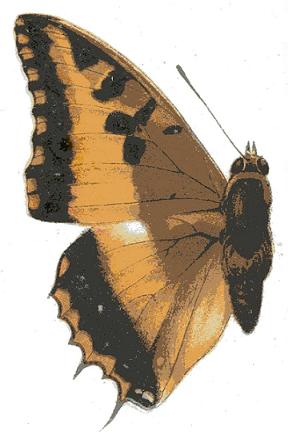
Charaxes druceanus, the silver-barred emperor or silver-barred charaxes, is a butterfly of the family Nymphalidae. It is found throughout tropical Africa.
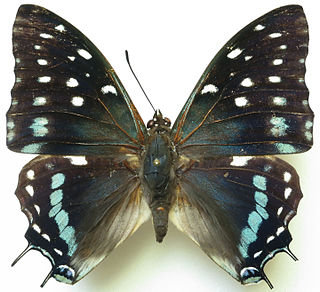
Charaxes etesipe, the savannah charaxes or scarce forest emperor, is a butterfly of the family Nymphalidae.
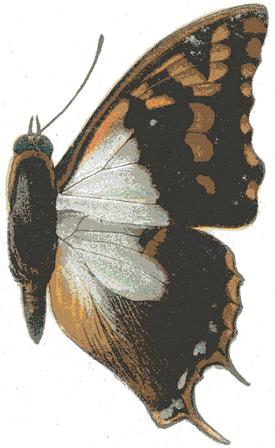
Charaxes lactetinctus, the blue patch charaxes, is a butterfly in the family Nymphalidae. It is found in Guinea, Ivory Coast, Ghana, Togo, Benin, Nigeria, Cameroon, the Republic of the Congo, the Central African Republic, the Democratic Republic of the Congo, Uganda, Kenya, Ethiopia and possibly Sudan.
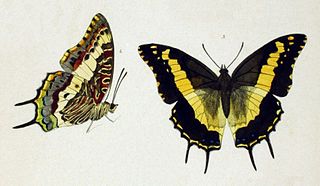
Charaxes hansali, the cream-banded charaxes, is a butterfly in the family Nymphalidae. It is found in Tanzania, Rwanda, Kenya, Uganda, Sudan, Ethiopia, Somalia, Saudi Arabia, Yemen and Oman.
Charaxes junius is a butterfly in the family Nymphalidae. It is found in Ethiopia and Sudan. The habitat consists of forests and woodland savanna.

Charaxes andara is a butterfly in the family Nymphalidae. It is found in eastern and southern Madagascar, where it is found in Afrotropical forests. It is very similar to Charaxes brutus, of which it has been considered a subspecies.

Charaxes ansorgei is a butterfly in the family Nymphalidae. It is found in Sudan, the Democratic Republic of Congo, Uganda, Rwanda, Burundi, Kenya, Tanzania, Malawi and Zambia. The habitat consists of montane forest on altitudes between 2,000 and 3,000 meters. The larvae feed on Bersama abyssinica abyssinica, Bersama abyssinica englerana and Bersama paullinoides.It was once considered to be a very rare species but it is relatively common in dense and inaccessible montane forests

Charaxes pollux, the black-bordered charaxes, is a butterfly in the family Nymphalidae.
Charaxes tectonis, the mountain silver-barred charaxes, is a butterfly in the family Nymphalidae. It is found in Nigeria and Cameroon. The habitat consists of sub-montane and montane forests.

Charaxes phraortes is a butterfly in the family Nymphalidae. It is found in north-eastern Madagascar. The habitat consists of wet coastal forests.
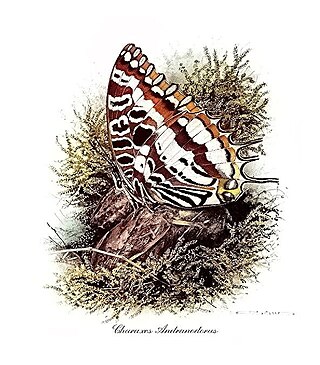
Charaxes andranodorus is a butterfly in the family Nymphalidae. It is found on Madagascar.

Charaxes eudoxus, the Eudoxus charaxes, is a butterfly in the family Nymphalidae. It is found in Guinea, Sierra Leone, Liberia, Ivory Coast, Ghana, Nigeria, Cameroon, Equatorial Guinea, Gabon, the Republic of the Congo, Angola, the Democratic Republic of the Congo, the Central African Republic, Sudan, Uganda, Rwanda, Burundi, Kenya, Tanzania, Cameroon and Zambia.
Charaxes lucyae is a butterfly in the family Nymphalidae. It is found in Tanzania.
Charaxes richelmanni is a butterfly in the family Nymphalidae. It is found in Cameroon, Gabon, the Republic of Congo, the Central African Republic, the Democratic Republic of Congo and Tanzania. The habitat consists of lowland evergreen forests.
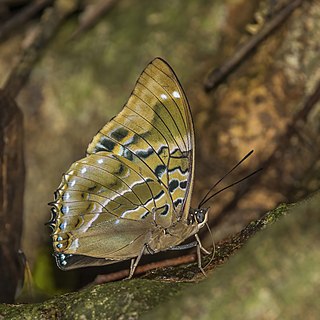
Charaxes numenes, the lesser blue charaxes, is a butterfly in the family Nymphalidae. It is found in Senegal, Guinea-Bissau, Guinea, Sierra Leone, Liberia, Ivory Coast, Ghana, Benin, Nigeria, Equatorial Guinea, Cameroon, Gabon, the Republic of the Congo, Angola, the Democratic Republic of the Congo, Zambia, the Central African Republic, Sudan, Ethiopia, Uganda, Kenya and Tanzania.

Charaxes baumanni, the little charaxes, is a butterfly in the family Nymphalidae. It is found in Sudan, Kenya, the Democratic Republic of the Congo, Uganda, Rwanda, Tanzania, Zambia, Malawi, Mozambique and Zimbabwe. The habitat consists of open forests and woodland.
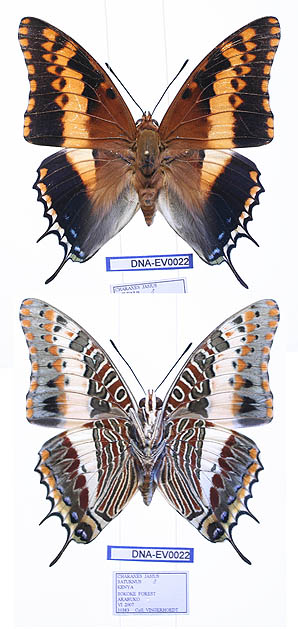
Charaxes saturnus, the foxy charaxes or koppie charaxes, is a butterfly that flies through most of the Savannah of the Eastern and Southern Afrotropical realm, and also occurs in suitable forest habitat locations including the forest belt of west-central Africa.














